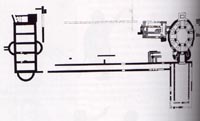
|
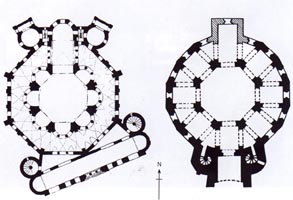
|
"Renovatio Romani Imperii"
On Christmas day 800 Charlemagne (768-814) was crowned Roman Emperor by Pope Leo III. The ceremony took place at St. Peter's in Rome. The imperial seal proclaimed the importance of the event with the motto: Renovatio Romani Imperii, or "Renovation of Imperial Rome." Charlemagne was hailed as a new Constantine and a new Augustus. Carolingians exploited the models presented by the Roman Imperial tradition to support Charlemagne's claim of an Imperium Christianum under his authority.
Einhard, a member of Charlemagne's court, wrote a famous biography of Charlemagne which was clearly based on the model of Roman Imperial biographies, especially that of Augustus, written by Suetonius. Review the excerpts of Einhard's biography. This page is linked to parallel passages from Suetonius's biography of Augustus. In reading this, note the priorities Einhard establishes for Charlemagne.
The architecture of the Carolingian period is likewise based on Roman models. Most tellingly here are the parallels between the Chapel Charlemagne constructs as part of his Palace complex in Aix-la-Chapelle or Aachen and San Vitale in Ravenna:

|

|
The German historian, Heinrich Fichtenau, includes in his book The Carolingian Empire a discussion of the symbolism of the Palace Chapel. As implied by Fichtenau, the palace chapel from its inception was intended as an image of the Heavenly Jerusalem. This is suggested by an inscription along the cornice of the interior which reads in translation as: "When the living stones are assembled harmoniously, and the numbers coincide in an equal manner, then rises resplendently the work of the Lord who has constructed the entire hall." Central to the symbolism was the relationship between Christ's rule over the heavenly kingdom represented by the mosaic of the Adoration of the Lamb by the Twenty-Four elders and the imperial throne in the tribune beneath. This relationship between the throne and the dome mosaic is restated in the facing pages from the Codex Aureus of St. Emmeram made for Charles the Bald c. 870:
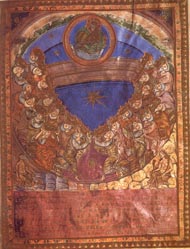 |
Even without the connections to the Palace Chapel, the Imperial symbolism of these pages from the Codex Aureus are evident. Compare for example the image of Charles the Bald enthroned to the Missorium of Theodosius:
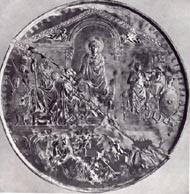
The small-scale statuette of an Equestrian Statue of a Carolingian king is clearly based on Roman Imperial models:
|
|

|
When Charlemagne visited Ravenna he took back from there an equestrian statue of Theodoric and placed in the courtyard of his Palace at Aix-la-Chapelle.
The gatehouse to the Monastery at Lorsch has long been compared with the tradition of Roman Triumphal Arches:
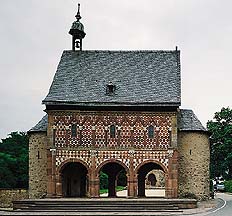
|
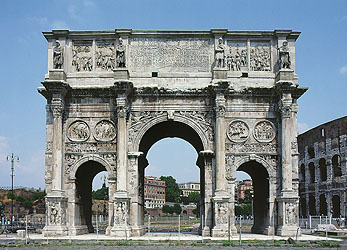
|
The Lorsch Gatehouse can also be compared to the Propylaeum that marked the entrance to the Church of St. Peter's in Rome:
Plan of the Abbey of St. Denis. The plan in black is the Carolingian church. Note the use of a transept in the plan. This is borrowed from the Old St. Peter's.
